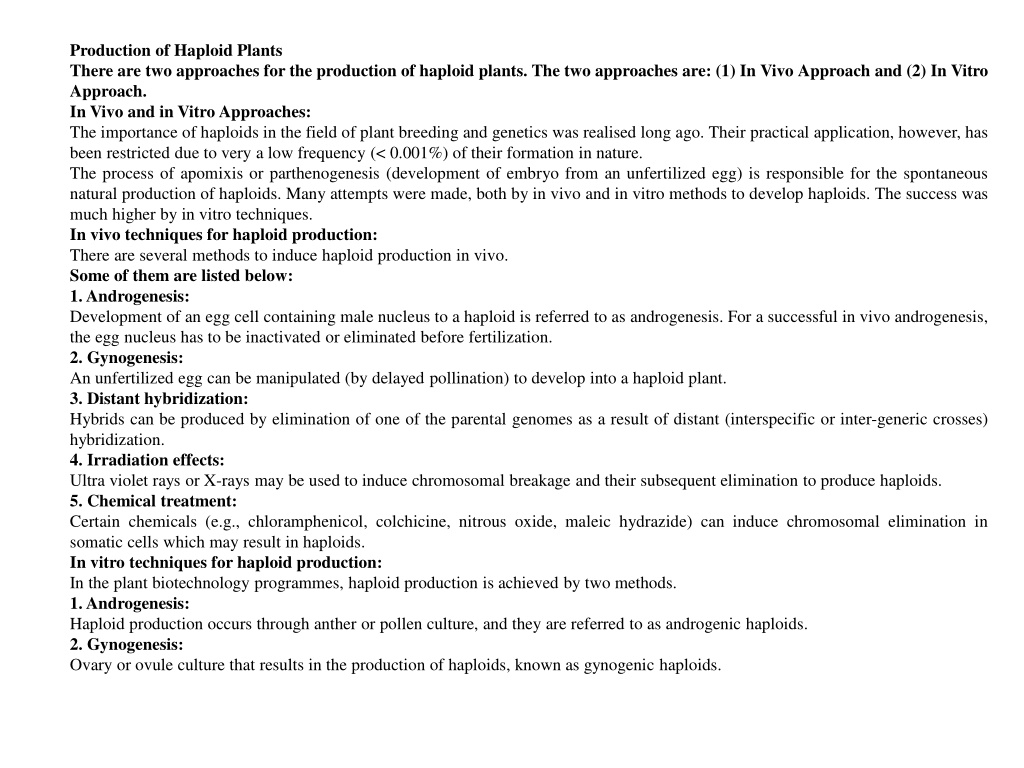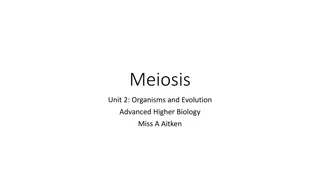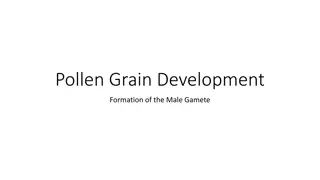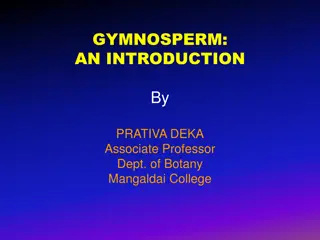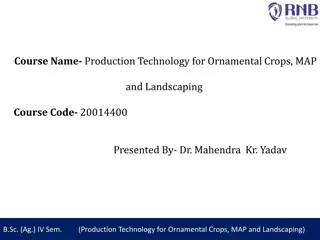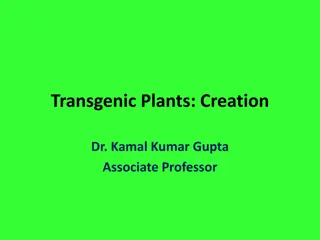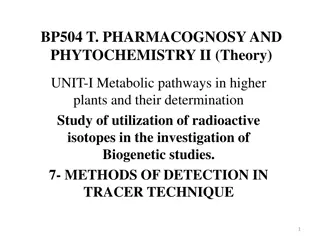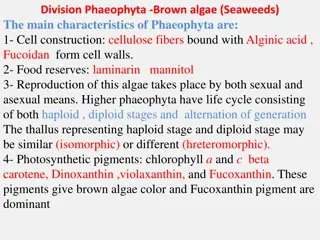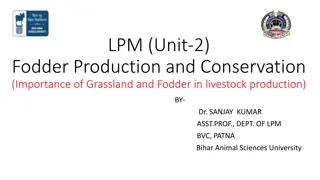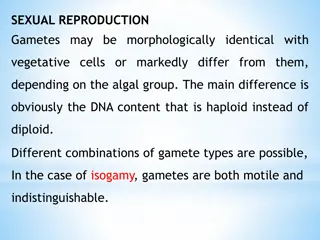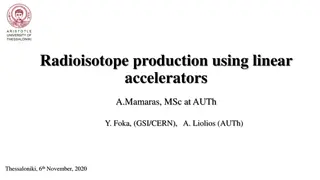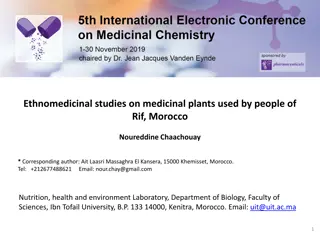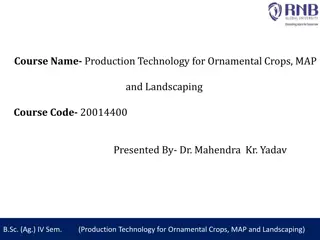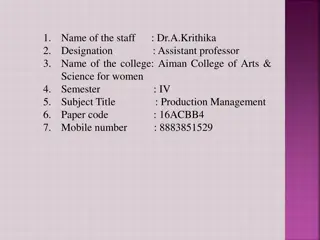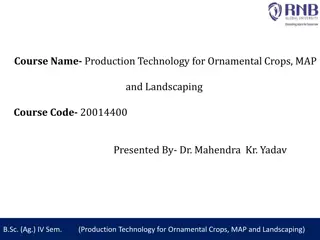Production of Haploid Plants: Approaches and Significance
There are two main approaches for haploid plant production - in vivo and in vitro methods. Haploids are important in plant breeding but are rare naturally. Various techniques like androgenesis, gynogenesis, distant hybridization, irradiation, and chemical treatments are used to induce haploid production. In vitro techniques involve androgenic and gynogenic haploids. Factors influencing androgenesis include genotype of donor plants and stage of microspore or pollen. Successful haploid production is crucial for plant biotechnology programs.
Download Presentation

Please find below an Image/Link to download the presentation.
The content on the website is provided AS IS for your information and personal use only. It may not be sold, licensed, or shared on other websites without obtaining consent from the author. Download presentation by click this link. If you encounter any issues during the download, it is possible that the publisher has removed the file from their server.
E N D
Presentation Transcript
Production of Haploid Plants There are two approaches for the production of haploid plants. The two approaches are: (1) In Vivo Approach and (2) In Vitro Approach. In Vivo and in Vitro Approaches: The importance of haploids in the field of plant breeding and genetics was realised long ago. Their practical application, however, has been restricted due to very a low frequency (< 0.001%) of their formation in nature. The process of apomixis or parthenogenesis (development of embryo from an unfertilized egg) is responsible for the spontaneous natural production of haploids. Many attempts were made, both by in vivo and in vitro methods to develop haploids. The success was much higher by in vitro techniques. In vivo techniques for haploid production: There are several methods to induce haploid production in vivo. Some of them are listed below: 1. Androgenesis: Development of an egg cell containing male nucleus to a haploid is referred to as androgenesis. For a successful in vivo androgenesis, the egg nucleus has to be inactivated or eliminated before fertilization. 2. Gynogenesis: An unfertilized egg can be manipulated (by delayed pollination) to develop into a haploid plant. 3. Distant hybridization: Hybrids can be produced by elimination of one of the parental genomes as a result of distant (interspecific or inter-generic crosses) hybridization. 4. Irradiation effects: Ultra violet rays or X-rays may be used to induce chromosomal breakage and their subsequent elimination to produce haploids. 5. Chemical treatment: Certain chemicals (e.g., chloramphenicol, colchicine, nitrous oxide, maleic hydrazide) can induce chromosomal elimination in somatic cells which may result in haploids. In vitro techniques for haploid production: In the plant biotechnology programmes, haploid production is achieved by two methods. 1. Androgenesis: Haploid production occurs through anther or pollen culture, and they are referred to as androgenic haploids. 2. Gynogenesis: Ovary or ovule culture that results in the production of haploids, known as gynogenic haploids.
Development of Androgenic Haploids: The process of in vitro androgenesis for the ultimate production of haploid plants is depicted in figure;
The cultured microspores mainly follow four distinct pathways during the initial stages of in vitro androgenesis. Pathway I: The uninucleate microspore undergoes equal division to form two daughter cells of equal size e.g. Datura innoxia. Pathway II: In certain plants, the microspore divides unequally to give bigger vegetative cell and a smaller generative cell. It is the vegetative cell that undergoes further divisions to form callus or embryo. The generative cell, on the other hand, degenerates after one or two divisions e.g., Nicotiana tabacum, Capsicum annuum. Pathway III: In this case, the microspore undergoes unequal division. The embryos are formed from the generative cell while the vegetative cell does not divide at all or undergoes limited number of divisions. Pathway IV: The microspore divides unequally as in pathways I and II. However, in this case, both vegetative and generative cells can further divide and contribute to the development of haploid plant e.g. Datura metel, Atropa belladonna. At the initial stages, the microspore may follow any one of the four pathways described above. As the cells divide, the pollen grain becomes multicellular and burst open. This multicellular mass may form a callus which later differentiates into a plant (through callus phase). Alternately, the multicellular mass may produce the plant through direct embryogenesis . Factors Affecting Androgenesis: A good knowledge of the various factors that influence androgenesis will help to improve the production of androgenic haploids. Some of these factors are briefly described. Genotype of donar plants: The success of anther or pollen culture largely depends on the genotype of the donor plant. It is therefore important to select only highly responsive genotypes. Some workers choose a breeding approach for improvement of genotype before they are used in androgenesis. Stage of microspore or pollen: The selection of anthers at an ideal stage of microspore development is very critical for haploid production. In general, microspores ranging from tetrad to bi-nucleate stages are more responsive. Anthers at a very young stage (with microspore mother cells or tetrads) and late stage (with bi-nucleate microspores) are usually not suitable for androgenesis. However, for maximum production of androgenic haploids, the suitable stage of microspore development is dependent on the plant species, and has to be carefully selected. Physiological status of a donar plant: The plants grown under best natural environmental conditions (light, temperature, nutrition, CO2 etc.) with good anthers and healthy microspores are most suitable as donor plants. Flowers obtained from young plants, at the beginning of the flowering season are highly responsive. The use of pesticides should be avoided at least 3-4 weeks preceding sampling. Pretreatment of anthers: The basic principle of native androgenesis is to stop the conversion of pollen cell into a gamete, and force its development into a plant. This is in fact an abnormal pathway induced to achieve in vitro androgenesis. Appropriate treatment of anthers is required for good success of haploid production.
Treatment methods are variable and largely depend on the donor plant species: 1. Chemical treatment: Certain chemicals are known to induce parthenogenesis e.g. 2-chloroethylphosphonic acid (ethrel). When plants are treated with ethreal, multinucleated pollens are produced. These pollens when cultured may form embryos. 2. Temperature influence: In general, when the buds are treated with cold temperatures (3-6 C) for about 3 days, induction occurs to yield pollen embryos in some plants e.g. Datura, Nicotiana. Further, induction of androgenesis is better if anthers are stored at low temperature, prior to culture e.g. maize, rye. There are also reports that pretreatment of anthers of certain plants at higher temperatures (35 C) stimulates androgenesis e.g. some species of Brassica and Capsicum. Effect of light: In general, the production of haploids is better in light. There are however, certain plants which can grow well in both light and dark. Isolated pollen (not the anther) appears to be sensitive to light. Thus, low intensity of light promotes development of embryos in pollen cultures e.g. tobacco. Effect of culture medium: The success of another culture and androgenesis is also dependent on the composition of the medium. There is, however, no single medium suitable for anther cultures of all plant species. The commonly used media for anther cultures are MS, White s, Nitsch and Nitsch, N6 and B5. These media in fact are the same as used in plant cell and tissue cultures. In recent years, some workers have developed specially designed media for anther cultures of cereals. Sucrose, nitrate, ammonium salts, amino acids and minerals are essential for androgenesis. In some species, growth regulators auxin and/or cytokinin are required for optimal growth. In certain plant species, addition of glutathione and ascorbic acid promotes androgenesis. When the anther culture medium is supplemented with activated charcoal, enhanced androgenesis is observed. It is believed that the activated charcoal removes the inhibitors from the medium and facilitates haploid formation. Gynogenesis: Haploid plants can be developed from ovary or ovule cultures. It is possible to trigger female gametophytes (megaspores) of angiosperms to develop into a sporophyte. The plants so produced are referred to as gynogenic haploids. Gynogenic haploids were first developed by San Noem (1976) from the ovary cultures of Hordeum vulgare. This technique was later applied for raising haploid plants of rice, wheat, maize, sunflower, sugar beet and tobacco. Limitations of Gynogenesis: In practice, production of haploid plants by ovary/ ovule cultures is not used as frequently as anther/ pollen cultures in crop improvement programmes. The major limitations of gynogenesis are listed: 1. The dissection of unfertilized ovaries and ovules is rather difficult. 2. The presence of only one ovary per flower is another disadvantage. In contrast, there are a large number of microspores in one another. However, the future of gynogenesis may be more promising with improved and refined methods.
